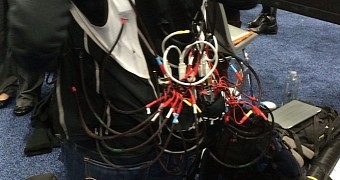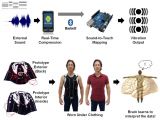Wearable technology is a broader term than you might think, since it's not just about wrist devices, arm-mounted contraptions and headsets anymore. Normal clothing has opened its doors wide as well, and the vest you see in the gallery is a result of that.
It's safe to say that the invention won't be marketed in its current form. However, it cannot be denied that its usefulness is considerable.
Deafness may not be as debilitating as blindness (few things are), but it can still have a significant impact on socialization and other parts involved in living a normal life.
Some people with hearing disabilities manage to learn how to read lips and even speak despite not having the frame of reference needed to learn it the proper way (you can't normally imitate speech without hearing it).
That doesn't help much when you're not facing the speaker directly, however, and it will also make it impossible to hear someone call for you or otherwise try to get your attention.
Neuroscientists create a tactile vest
Seen in the attached gallery, the vest contains a slew of electronic components which allow it to hear in your stead, in a manner of speaking.
It's not impossible to regain the ability to distinguish sound, but unless you're under the age of twelve and have a lot of money to cover an invasive surgery, you're mostly out of luck.
That leaves 53 million people worldwide who can't hear (not counting those that never bothered revealing their condition to surveys). Two million of them are in the United States.
Seeing this, two neuroscientists from Baylor College of Medicine in Houston, Texas, set about creating a device that swaps the sense of hearing with that of touch.
Scott Novich and David Eagleman created the versatile extra-sensory transducer (or VEST for short) from a microphone, an Android tablet / phone, and a bunch of buzzers installed at the back of the piece of clothing.
It doesn't matter what tablet or phone you own as long as it has the app needed to change the sounds into vibrations.
The method is pretty straightforward actually: the sounds are captured by the microphone and fed to the mobile device which translates them and prompts the receptors to produce vibrations accordingly.
Test results
Several deaf and hearing volunteers wore the VEST for a while and were asked to guess the word being spoken based on how the vest vibrated. Depending on how easy they found it (four tries maximum), Novich and Eagleman refined their algorithms.
300 to 600 trials were made per day, until the wearers reached a point where 75% of their guesses were correct. The next phase of tests will have the subjects wear the VEST for six weeks.
When the electronic clothing is finalized, it will cost less than $2,000 / €2,000.
"At the end of the day, your sensory receptors are all sending electrical signals to the brain," Novich told Live Science. "Your receptors are tuned for a specific kind of information, but there's nothing saying you actually have to send that type of information."

 14 DAY TRIAL //
14 DAY TRIAL // 



